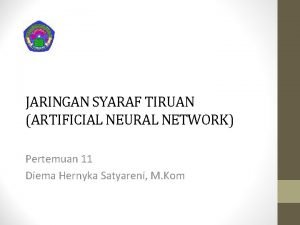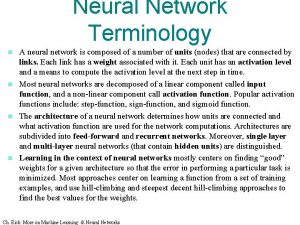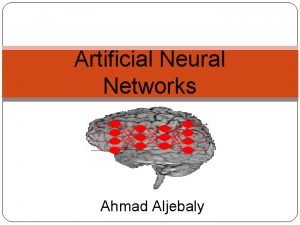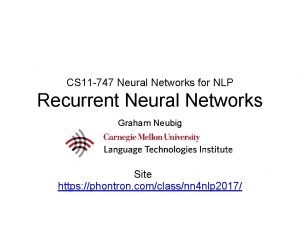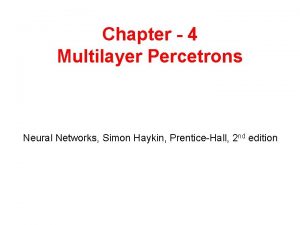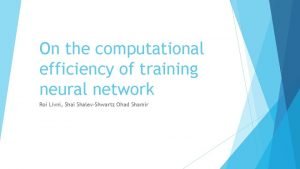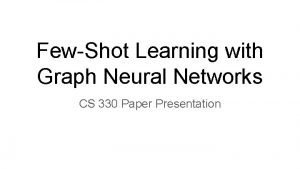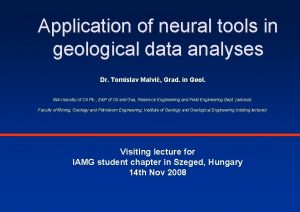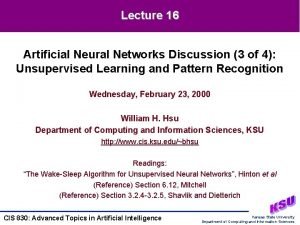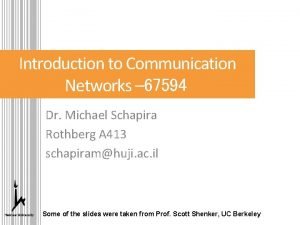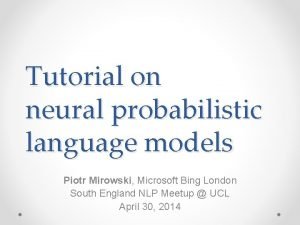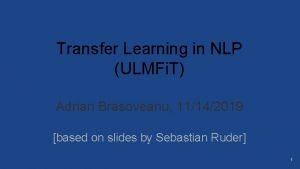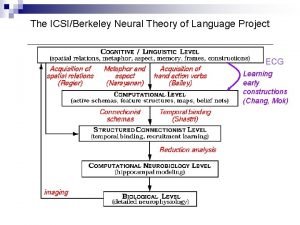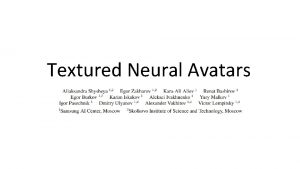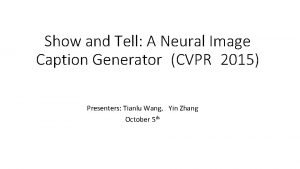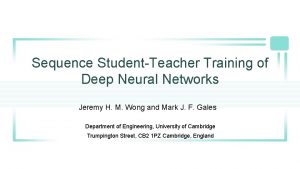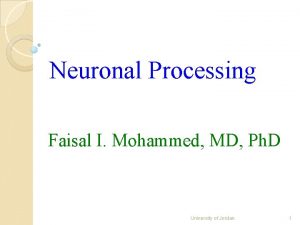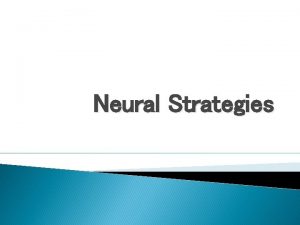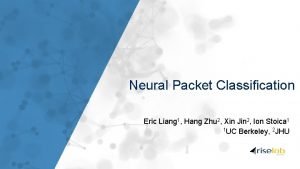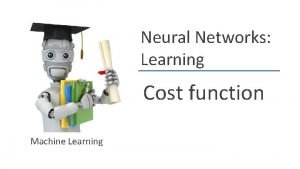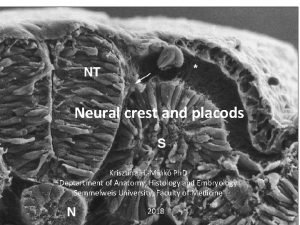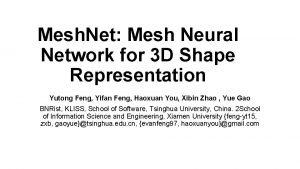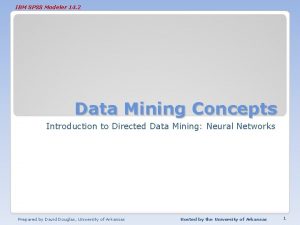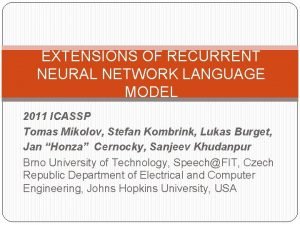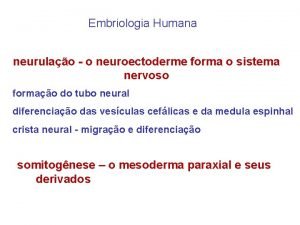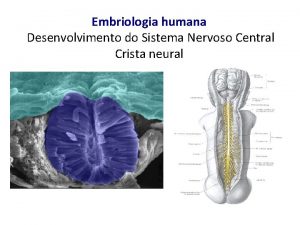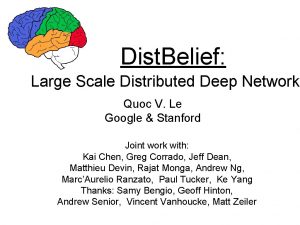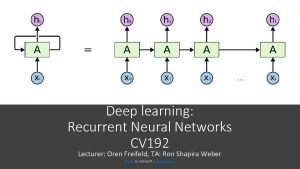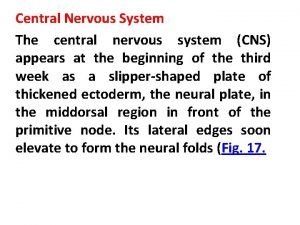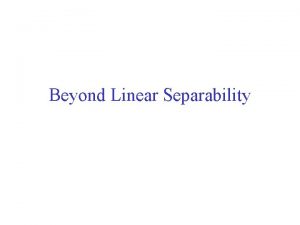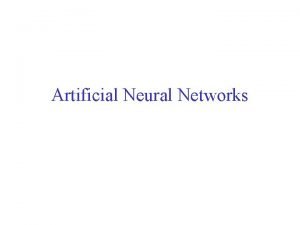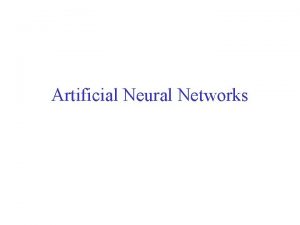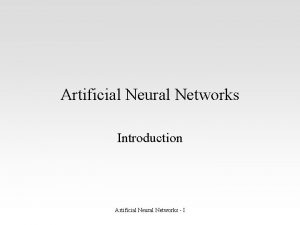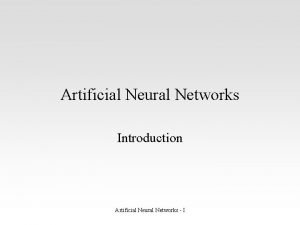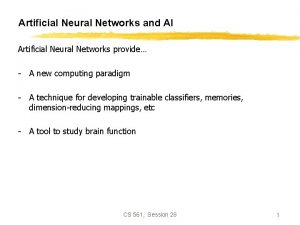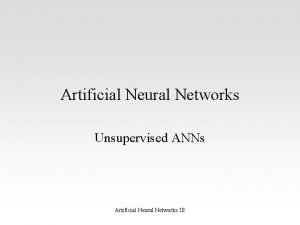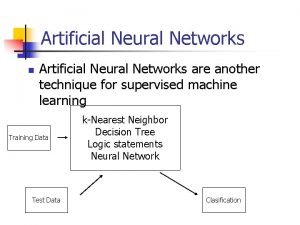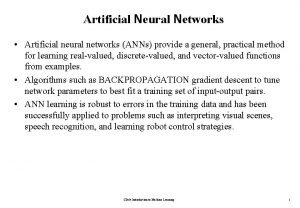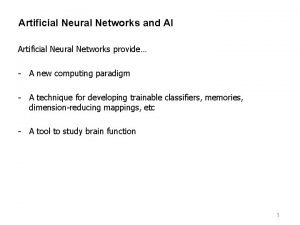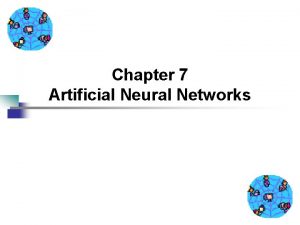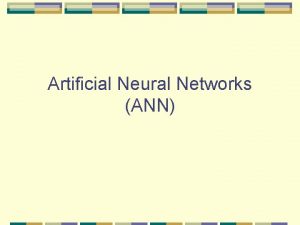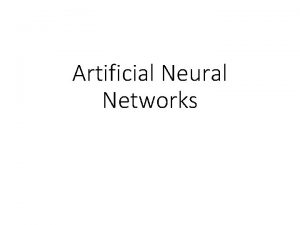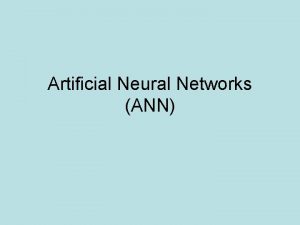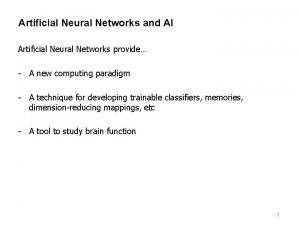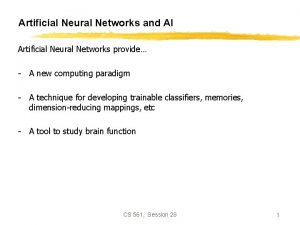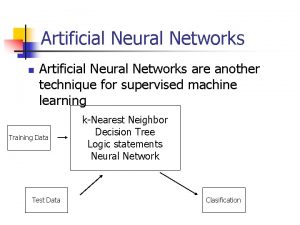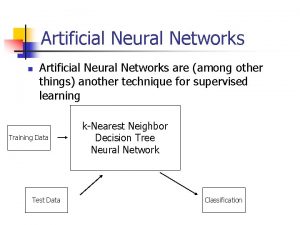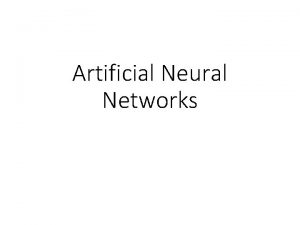Artificial Neural Networks Introduction n Artificial Neural Networks











































































- Slides: 75

Artificial Neural Networks

Introduction n Artificial Neural Networks (ANN) ¨ Information processing paradigm inspired by biological nervous systems ¨ ANN is composed of a system of neurons connected by synapses ¨ ANN learn by example n Adjust synaptic connections between neurons

History n 1943: Mc. Culloch and Pitts model neural networks based on their understanding of neurology. ¨ Neurons embed n a or b n a and b n simple logic functions: 1950 s: ¨ Farley and Clark n IBM group that tries to model biological behavior n Consult neuro-scientists at Mc. Gill, whenever stuck ¨ Rochester, Holland, Haibit and Duda

History n Perceptron (Rosenblatt 1958) ¨ Three layer system: n Input nodes n Output node n Association layer ¨ Can learn to connect random output unit n or associate a given input to a Minsky and Papert ¨ Showed that a single layer perceptron cannot learn the XOR of two binary inputs ¨ Lead to loss of interest (and funding) in the field

History n Perceptron (Rosenblatt 1958) ¨ Association units A 1, A 2, … extract features from user input ¨ Output is weighted and associated ¨ Function fires if weighted sum of input exceeds a threshold.

History n Back-propagation learning method (Werbos 1974) ¨ Three layers of neurons n Input, Output, Hidden ¨ Better learning rule for generic three layer networks ¨ Regenerates interest in the 1980 s n n Successful applications in medicine, marketing, risk management, … (1990) In need for another breakthrough.

ANN n Promises ¨ Combine speed of silicon with proven success of carbon artificial brains

Neuron Model n Natural neurons

Neuron Model n n n Neuron collects signals from dendrites Sends out spikes of electrical activity through an axon, which splits into thousands of branches. At end of each brand, a synapses converts activity into either exciting or inhibiting activity of a dendrite at another neuron. Neuron fires when exciting activity surpasses inhibitory activity Learning changes the effectiveness of the synapses

Neuron Model n Natural neurons

Neuron Model n Abstract neuron model:

ANN Forward Propagation

ANN Forward Propagation n Bias Nodes ¨ Add one node to each layer that has constant output n Forward propagation ¨ Calculate from input layer to output layer ¨ For each neuron: Calculate weighted average of input n Calculate activation function n

Neuron Model n Firing Rules: ¨ Threshold n n rules: Calculate weighted average of input Fire if larger than threshold ¨ Perceptron n n rule Calculate weighted average of input Output activation level is

Neuron Model n Firing Rules: Sigmoid functions: ¨ Hyperbolic ¨ Logistic tangent function activation function

ANN Forward Propagation

ANN Forward Propagation n n Apply input vector X to layer of neurons. Calculate ¨ where Xi is the activation of previous layer neuron i ¨ Wji is the weight of going from node i to node j ¨ p is the number of neurons in the previous layer n Calculate output activation

ANN Forward Propagation n Example: ADALINE Neural Network ¨ Calculates 0 1 2 Bias Node and of inputs w 0, 3=. 6 w 1, 3=. 6 w 2, 3=-. 9 3 threshold function is step function

ANN Forward Propagation n Example: Three layer network ¨ Calculates -4. 8 0 xor of inputs 2 5. 9 5. 1 4 4. 6 1 3 -5. 2 -3. 2 5. 2 -2. 6 Bias -2. 7

ANN Forward Propagation n Input (0, 0) -4. 8 0 2 5. 9 5. 1 4 4. 6 1 3 -5. 2 -3. 2 5. 2 -2. 6 Bias -2. 7

ANN Forward Propagation n Input (0, 0) ¨ Node 2 activation is (-4. 8 0+4. 6 0 - 2. 6)= 0. 0691 -4. 8 0 2 5. 9 5. 1 4 4. 6 1 3 -5. 2 -3. 2 5. 2 -2. 6 Bias -2. 7

ANN Forward Propagation n Input (0, 0) ¨ Node 3 activation is (5. 1 0 - 5. 2 0 - 3. 2)= 0. 0392 -4. 8 0 2 5. 9 5. 1 4 4. 6 1 3 -5. 2 -3. 2 5. 2 -2. 6 Bias -2. 7

ANN Forward Propagation n Input (0, 0) ¨ Node 4 activation is (5. 9 0. 069 + 5. 2 0. 069 – 2. 7)= 0. 110227 -4. 8 0 2 5. 9 5. 1 4 4. 6 1 3 -5. 2 -3. 2 5. 2 -2. 6 Bias -2. 7

ANN Forward Propagation n Input (0, 1) ¨ Node 2 activation is (4. 6 -2. 6)= 0. 153269 -4. 8 0 2 5. 9 5. 1 4 4. 6 1 3 -5. 2 -3. 2 5. 2 -2. 6 Bias -2. 7

ANN Forward Propagation n Input (0, 1) ¨ Node 3 activation is (-5. 2 -3. 2)= 0. 000224817 -4. 8 0 2 5. 9 5. 1 4 4. 6 1 3 -5. 2 -3. 2 5. 2 -2. 6 Bias -2. 7

ANN Forward Propagation n Input (0, 1) ¨ Node 4 activation is (5. 9 0. 153269 + 5. 2 0. 000224817 -2. 7 )= 0. 923992 -4. 8 0 2 5. 9 5. 1 4 4. 6 1 3 -5. 2 -3. 2 5. 2 -2. 6 Bias -2. 7

ANN Forward Propagation n Density Plot of Output

ANN Forward Propagation

ANN Forward Propagation Network can learn a non-linearly separated set of outputs. n Need to map output (real value) into binary values. n

ANN Training n Weights are determined by training ¨ Back-propagation: On given input, compare actual output to desired output. n Adjust weights to output nodes. n Work backwards through the various layers n ¨ Start n out with initial random weights Best to keep weights close to zero (<<10)

ANN Training n Weights are determined by training ¨ Need n a training set Should be representative of the problem ¨ During each training epoch: Submit training set element as input n Calculate the error for the output neurons n Calculate average error during epoch n Adjust weights n

ANN Training n Error is the mean square of differences in output layer y – observed output t – target output

ANN Training n Error of training epoch is the average of all errors.

ANN Training n Update weights and thresholds using ¨ Weights ¨ Bias ¨ is a possibly time-dependent factor that should prevent overcorrection

ANN Training n Using a sigmoid function, we get ¨ Logistics function has derivative ’(t) = (t)(1 - (t))

ANN Training Example n Start out with random, small weights -0, 5 0 2 4 1 1 3 -1 x 2 y 0 0 0. 687349 0 1 0. 667459 1 0 0. 698070 1 1 0. 676727 0. 1 -0. 5 1 x 1 -0. 5 Bias 1

ANN Training Example 0 1 -0, 5 -0. 5 1 1 2 0. 1 4 3 -1 -0. 5 1 x 2 0 0 0. 69 0. 472448 0 1 0. 67 0. 110583 1 0 0. 70 0. 0911618 1 1 0. 68 0. 457959 Bias Average Error is 0. 283038 y Error

ANN Training Example 0 1 -0, 5 -0. 5 1 1 2 0. 1 4 3 -1 -0. 5 1 x 2 0 0 0. 69 0. 472448 0 1 0. 67 0. 110583 1 0 0. 70 0. 0911618 1 1 0. 68 0. 457959 Bias Average Error is 0. 283038 y Error

ANN Training Example n Calculate the derivative of the error with respect to the weights and bias into the output layer neurons

ANN Training Example 0 1 -0, 5 -0. 5 1 1 New weights going into node 4 2 0. 1 4 3 -1 -0. 5 Bias 1 We do this for all training inputs, then average out the changes net 4 is the weighted sum of input going into neuron 4: net 4(0, 0)= 0. 787754 net 4(0, 1)= 0. 696717 net 4(1, 0)= 0. 838124 net 4(1, 1)= 0. 73877

ANN Training Example 0 1 -0, 5 -0. 5 1 1 New weights going into node 4 2 0. 1 4 3 -1 -0. 5 Bias We calculate the derivative of the activation function at the point given by the net-input. Recall our cool formula 1 ’(t) = (t)(1 - (t)) ’( net 4(0, 0)) = ’( 0. 787754) = 0. 214900 ’( net 4(0, 1)) = ’( 0. 696717) = 0. 221957 ’( net 4(1, 0)) = ’( 0. 838124) = 0. 210768 ’( net 4(1, 1)) = ’( 0. 738770) = 0. 218768

ANN Training Example New weights going into node 4 0 1 -0, 5 -0. 5 1 1 2 We now obtain values for each input separately: 0. 1 4 3 -1 -0. 5 Bias Input 0, 0: 4= ’( net 4(0, 0)) *(0 -y 4(0, 0)) = -0. 152928 1 Input 0, 1: 4= ’( net 4(0, 1)) *(1 -y 4(0, 1)) = 0. 0682324 Input 1, 0: 4= ’( net 4(1, 0)) *(1 -y 4(1, 0)) = 0. 0593889 Input 1, 1: 4= ’( net 4(1, 1)) *(0 -y 4(1, 1)) = -0. 153776 Average: 4 = -0. 0447706

ANN Training Example New weights going into node 4 0 1 -0, 5 -0. 5 1 1 2 0. 1 4 3 -1 -0. 5 Bias 1 Average: 4 = -0. 0447706 We can now update the weights going into node 4: Let’s call: Eji the derivative of the error function with respect to the weight going from neuron i into neuron j. We do this for every possible input: E 4, 2 = - output(neuron(2)* 4 For (0, 0): E 4, 2 = 0. 0577366 For (0, 1): E 4, 2 = -0. 0424719 For(1, 0): E 4, 2 = -0. 0159721 For(1, 1): E 4, 2 = 0. 0768878 Average is 0. 0190451

ANN Training Example 0 1 -0, 5 -0. 5 1 1 2 0. 1 4 3 -1 -0. 5 Bias 1 New weight from 2 to 4 is now going to be 0. 1190451.

ANN Training Example New weights going into node 4 0 1 -0, 5 -0. 5 1 1 2 For (0, 0): E 4, 3 = 0. 0411287 0. 1 4 3 -1 -0. 5 1 For (0, 1): E 4, 3 = -0. 0341162 For(1, 0): E 4, 3 = -0. 0108341 For(1, 1): E 4, 3 = 0. 0580565 Average is 0. 0135588 Bias New weight is -0. 486441

ANN Training Example New weights going into node 4: 0 1 -0, 5 -0. 5 1 1 We also need to change the bias node 2 0. 1 4 3 -1 -0. 5 Bias 1 For (0, 0): E 4, B = 0. 0411287 For (0, 1): E 4, B = -0. 0341162 For(1, 0): E 4, B = -0. 0108341 For(1, 1): E 4, B = 0. 0580565 Average is 0. 0447706 New weight is 1. 0447706

ANN Training Example n n We now have adjusted all the weights into the output layer. Next, we adjust the hidden layer The target output is given by the delta values of the output layer More formally: Assume that j is a hidden neuron ¨ Assume that k is the delta-value for an output neuron k. ¨ While the example has only one output neuron, most ANN have more. When we sum over k, this means summing over all output neurons. ¨ wkj is the weight from neuron j into neuron k ¨

ANN Training Example We now calculate the updates to the weights of neuron 2. 0 1 -0, 5 -0. 5 1 1 2 First, we calculate the net-input into 2. 0. 1 4 3 -1 -0. 5 Bias 1 This is really simple because it is just a linear functions of the arguments x 1 and x 2 net 2 = -0. 5 x 1 + x 2 - 0. 5 We obtain 2 (0, 0) = - 0. 00359387 2(0, 1) = 0. 00160349 2(1, 0) = 0. 00116766 2(1, 1) = - 0. 00384439

ANN Training Example 0 1 -0, 5 -0. 5 1 1 2 0. 1 4 3 -1 -0. 5 Bias 1 Call E 20 the derivative of E with respect to w 20. We use the output activation for the neurons in the previous layer (which happens to be the input layer) E 20 (0, 0) = - (0) 2 (0, 0) = 0. 00179694 E 20(0, 1) = 0. 00179694 E 20(1, 0) = -0. 000853626 E 20(1, 1) = 0. 00281047 The average is 0. 00073801 and the new weight is -0. 499262

ANN Training Example 0 1 -0, 5 -0. 5 1 1 2 0. 1 4 3 -1 -0. 5 Bias 1 Call E 21 the derivative of E with respect to w 21. We use the output activation for the neurons in the previous layer (which happens to be the input layer) E 21 (0, 0) = - (1) 2 (0, 0) = 0. 00179694 E 21(0, 1) = -0. 00117224 E 21(1, 0) = -0. 000583829 E 21(1, 1) = 0. 00281047 The average is 0. 000712835 and the new weight is 1. 00071

ANN Training Example 0 1 -0, 5 -0. 5 1 1 2 Call E 2 B the derivative of E with respect to w 2 B. Bias output is always -0. 5 0. 1 4 3 -1 -0. 5 1 E 2 B (0, 0) = - -0. 5 2 (0, 0) = E 2 B(0, 1) = -0. 00117224 E 2 B(1, 0) = -0. 000583829 E 2 B(1, 1) = 0. 00281047 0. 00179694 Bias The average is 0. 00058339 and the new weight is -0. 499417

ANN Training Example We now calculate the updates to the weights of neuron 3. 0 1 -0, 5 -0. 5 1 1 2 0. 1 4 3 -1 -0. 5 Bias 1 …

ANN Training n ANN Back-propagation is an empirical algorithm

ANN Training XOR is too simple an example, since quality of ANN is measured on a finite sets of inputs. n More relevant are ANN that are trained on a training set and unleashed on real data n

ANN Training n Need to measure effectiveness of training ¨ Need n training sets test sets. There can be no interaction between test sets and training sets. ¨ Example ¨ ¨ n of a Mistake: Train ANN on training set. Test ANN on test set. Results are poor. Go back to training ANN. After this, there is no assurance that ANN will work well in practice. ¨ In a subtle way, the test set has become part of the training set.

ANN Training n Convergence ANN back propagation uses gradient decent. ¨ Naïve implementations can ¨ n overcorrect weights undercorrect weights In either case, convergence can be poor Stuck in the wrong place ANN starts with random weights and improves them ¨ If improvement stops, we stop algorithm ¨ No guarantee that we found the best set of weights ¨ Could be stuck in a local minimum ¨

ANN Training n Overtraining ¨ An ANN can be made to work too well on a training set ¨ But loose performance on test sets Performance Training set Test set Training time

ANN Training n Overtraining Assume we want to separate the red from the green dots. ¨ Eventually, the network will learn to do well in the training case ¨ But have learnt only the particularities of our training set ¨

ANN Training n Overtraining

ANN Training n Improving Convergence ¨ Many Operations Research Tools apply Simulated annealing n Sophisticated gradient descent n

ANN Design n ANN is a largely empirical study ¨ “Seems to work in almost all cases that we know about” n Known to be statistical pattern analysis

ANN Design n Number of layers ¨ Apparently, three layers is almost always good enough and better than four layers. ¨ Also: fewer layers are faster in execution and training n How many hidden nodes? ¨ Many hidden nodes allow to learn more complicated patterns ¨ Because of overtraining, almost always best to set the number of hidden nodes too low and then increase their numbers.

ANN Design n Interpreting Output ¨ ANN’s output neurons do not give binary values. Good or bad n Need to define what is an accept. n ¨ Can indicate n degrees of certainty with n-1 output neurons. n Number of firing output neurons is degree of certainty

ANN Applications n Pattern recognition Network attacks ¨ Breast cancer ¨ … ¨ handwriting recognition ¨ n n Pattern completion Auto-association ¨ ANN trained to reproduce input as output n n Noise reduction Compression Finding anomalies Time Series Completion

ANN Future ANNs can do some things really well n They lack in structure found in most natural networks n

Pseudo-Code phi – activation function n phid – derivative of activation function n

Pseudo-Code n Forward Propagation: ¨ Input nodes i, given foreach inputnode i outputi = xi input xi: ¨ Hidden layer nodes j foreach hiddenneuron j outputj = i phi(wji outputi) ¨ Output layer neurons k foreach outputneuron k outputk = k phi(wkj outputj)

Pseudo-Code Activate. Layer(input, output) foreach i inputneuron calculate outputi foreach j hiddenneuron calculate outputj foreach k hiddenneuron calculate outputk output = {outputk}

Pseudo-Code n Output Error() { foreach input in Input. Set Errorinput = k output neuron (targetk-outputk)2 return Average(Errorinput, Input. Set)

Pseudo-Code n Gradient Calculation ¨ We calculate the gradient of the error with respect to a given weight wkj. ¨ The gradient is the average of the gradients for all inputs. ¨ Calculation proceeds from the output layer to the hidden layer

Pseudo-Code For each output neuron k calculate: For each output neuron k calculate and hidden layer neuron j calculate:

Pseudo-Code For each hidden neuron j calculate: For each hidden neuron j and each input neuron i calculate:

Pseudo-Code These calculations were done for a single input. n Now calculate the average gradient over all inputs (and for all weights). n You also need to calculate the gradients for the bias weights and average them. n

Pseudo-Code n Naïve back-propagation code: ¨ Initialize weights to a small random value (between -1 and 1) ¨ For a maximum number of iterations do n n Calculate average error for all input. If error is smaller than tolerance, exit. For each input, calculate the gradients for all weights, including bias weights and average them. If length of gradient vector is smaller than a small value, then stop. Otherwise: ¨ Modify all weights by adding a negative multiple of the gradient to the weights.

Pseudo-Code n This naïve algorithm has problems with convergence and should only be used for toy problems.
 Toolbox neural network matlab
Toolbox neural network matlab What is stride in cnn
What is stride in cnn Xooutput
Xooutput Pengertian artificial neural network
Pengertian artificial neural network Artificial neural network in data mining
Artificial neural network in data mining Artificial neural network terminology
Artificial neural network terminology Conclusion of artificial neural network
Conclusion of artificial neural network Visualizing and understanding convolutional neural networks
Visualizing and understanding convolutional neural networks Vc dimension neural network
Vc dimension neural network Neural pruning ib psychology
Neural pruning ib psychology Audio super resolution using neural networks
Audio super resolution using neural networks Convolutional neural networks for visual recognition
Convolutional neural networks for visual recognition Style transfer
Style transfer Nvdla
Nvdla Mippers
Mippers Neural networks and learning machines 3rd edition
Neural networks and learning machines 3rd edition Pixelrnn
Pixelrnn Neural networks for rf and microwave design
Neural networks for rf and microwave design 11-747 neural networks for nlp
11-747 neural networks for nlp Xor problem
Xor problem Sparse convolutional neural networks
Sparse convolutional neural networks On the computational efficiency of training neural networks
On the computational efficiency of training neural networks Tlu neural networks
Tlu neural networks Neural networks and fuzzy logic
Neural networks and fuzzy logic Lmu cis
Lmu cis Few shot learning with graph neural networks
Few shot learning with graph neural networks Deep forest: towards an alternative to deep neural networks
Deep forest: towards an alternative to deep neural networks Convolutional neural networks
Convolutional neural networks Neuraltools neural networks
Neuraltools neural networks Andrew ng recurrent neural networks
Andrew ng recurrent neural networks Predicting nba games using neural networks
Predicting nba games using neural networks Neural networks and learning machines
Neural networks and learning machines The wake-sleep algorithm for unsupervised neural networks
The wake-sleep algorithm for unsupervised neural networks Audio super resolution using neural networks
Audio super resolution using neural networks Alternatives to convolutional neural networks
Alternatives to convolutional neural networks Datagram network and virtual circuit network
Datagram network and virtual circuit network Backbone networks in computer networks
Backbone networks in computer networks Pxdes expert system
Pxdes expert system Cpsc 322: introduction to artificial intelligence
Cpsc 322: introduction to artificial intelligence Cpsc 322 ubc
Cpsc 322 ubc Introduction to storage area networks
Introduction to storage area networks Wan switching
Wan switching Introduction to communication networks
Introduction to communication networks Introduction to wide area networks
Introduction to wide area networks Introduction to switched networks
Introduction to switched networks Essay structure
Essay structure A neural probabilistic language model
A neural probabilistic language model Dan brasoveanu
Dan brasoveanu Neural circuits the organization of neuronal pools
Neural circuits the organization of neuronal pools Neural theory
Neural theory Textured neural avatars
Textured neural avatars Dilatações do tubo neural
Dilatações do tubo neural Show not tell generator
Show not tell generator Student teacher neural network
Student teacher neural network Paraxial mesoderm
Paraxial mesoderm Neural circuits the organization of neuronal pools
Neural circuits the organization of neuronal pools Spna bifida
Spna bifida Neural strategies pdhpe
Neural strategies pdhpe Neural packet classification
Neural packet classification Cost function in deep learning
Cost function in deep learning Neural plate
Neural plate Meshnet: mesh neural network for 3d shape representation
Meshnet: mesh neural network for 3d shape representation Neural network in r
Neural network in r Spss neural network
Spss neural network Xkcd neural network
Xkcd neural network Identify each type of neuronal pool
Identify each type of neuronal pool Extensions of recurrent neural network language model
Extensions of recurrent neural network language model Neural plate formation
Neural plate formation Somito
Somito Gastrulação
Gastrulação Neural language model
Neural language model Lstm colah
Lstm colah Fig 19
Fig 19 Humoral neural and hormonal stimuli
Humoral neural and hormonal stimuli Alar plate of neural tube
Alar plate of neural tube Limitations of perceptron
Limitations of perceptron



